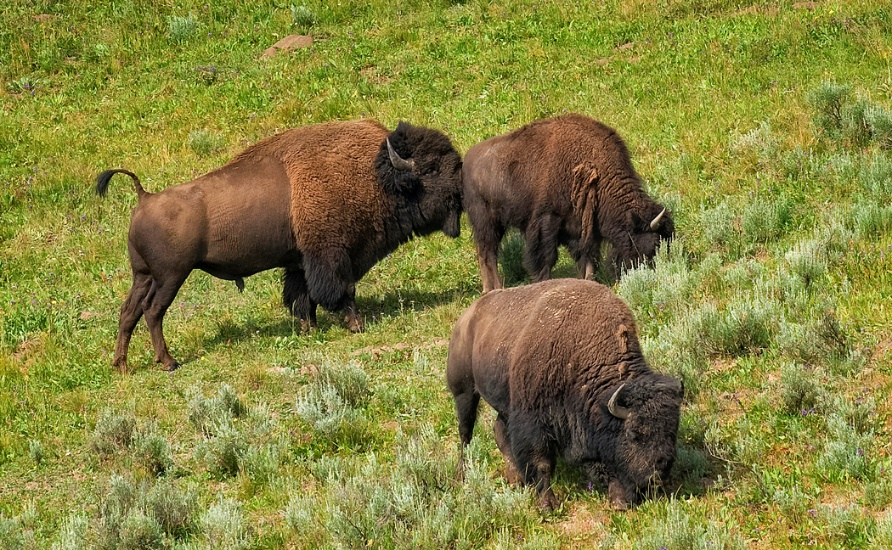Recent NEWS items presented two different numbers for plains bison
herds with reliable mandates to restore and maintain wild, public
bison. March 13 NEWS referred to 13 herds; upon further study, March
27 NEWS referred to only 10 herds. Here we clarify this change.
To qualify, a
herd must be managed as public-trust bison, with primary management
to develop and maintain natural selection that is preponderant over
artificial selection and genetic drift. Only Department of Interior
herds, under the Park Service or under Fish & Wildlife Service
Refuges qualify under relatively dependable legal mandates for
wildness enacted by Congress.
Previous news
releases from the Department of Interior claimed as many as 19
federal bison herds with 11,000 bison are managed for biotic
diversity and biotic integrity – the equivalent of “wildness”.
Subsequent news releases by this and other organizations have reduced
this number to 16, 13, and now 10. Nine of the alleged 19 public,
wild herds are:
2 herds in Alaska -- Not on native plains bison range.
1 herd on the Bison Range in Montana -- Recently ceded to the
Kootenai/Salish Tribes.
2 herds in Utah -- Book Cliffs and Henry Mountains herds: spend
some or much time on federal lands; but are managed and limited as
state game animals and (Book Cliffs) by the northern Ute Tribe.
1 herd in Wyoming -- Jackson Hole herd: co-managed as state game;
recently reduced from 1000 to 500.
1 herd in Arizona -- Has habitat in Grand Canyon National Park:
co-managed as state game to limit numbers and consequent damage to
Park’s prehistoric relics.
2 herds in Colorado and Kansas -- co-managed with The Nature
Conservancy; have some federal habitat, but most habitat is TNC.
Likely,
Department of Interior has collaborative agreements to exchange
animals between these 9 herds and Interior herds to limit loss of
alleles to genetic drift. However, excluding 2 herds in Alaska, the
management priorities for these herds include production as game or
for sale, limiting competition with private livestock, or other
priorities that detract from managing for wildness.
Thus, the
future of wild plains bison genomes, south of Canada, depends upon
the remaining 10 herds, with approximate herd sizes totaling 7,880
bison and only 2 herds with at least 1000 bison to forestall
weakening of natural selection by genetic drift. These herds are:
Yellowstone National Park: 4800 bison, not welcome in
surrounding states.
Badlands NP: 1000 bison (new management plan coming).
Wichita Mountains National Wildlife Refuge: 650 bison.
Theodore Roosevelt NP: 525 bison (south herd: 350; north herd:
175).
Wind Cave NP: 400 bison.
Fort Niobrara NWR: 350 bison (includes separate “Sully” herd of
60).
Neal Smith NWR: 70 bison.
Rocky Mountain Arsenal NWR: 55 bison.
Whitehorse Hill Nat. Game Preserve: 20 bison.
Chickasaw Nat. Recreation Area: 10 bison.
These 10 herds
are critical to preserving examples of genetically wild bison within
the public trust. In the long run, they will be inadequate. Herds
less than 100 must be enlarged. Additional large herds on large,
diverse landscapes are needed.
Three large or
growing private herds1 may contribute some to saving
“wild” alleles; but their management today includes some
artificial selection, and limited natural selection, and they are not
public-trust herds. There is no evidence that any Tribal herds have
management priorities to retain wildness of bison. One impressive
Tribal attempt was abandoned in 20042.
1TNC
Tallgrass Preserve in OK; TNC Medano Ranch in CO; American Prairie in
MT.
2Braun,
F. F. 2008. Buffalo, Inc. University of Oklahoma Press, Norman, OK.
p. 235.

